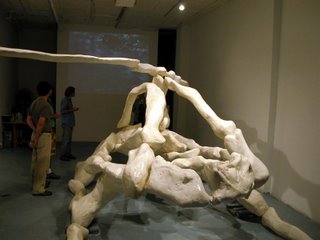Ilan Sandler's big book



Another great Canadian (have I mentioned that Rev. Luke Murphy and Jillian Mcdonald are both proud holders of Canadian passports?) has created some enormous and sexy looking art in Nova Scotia. Ilan has previously erected an equally huge helicopter out of fake dinosaur bones at vertexList. This time it is about language; and here is what Ilan has to say about it on his website:
"The Book is a steel sculpture with two pages torn away from its spine. The spine is perpendicular to the ground, the covers are open, and the pages appear to blow in the wind. From the highway viewers see a book that looks as if it were lifted by the wind and oriented towards a sheet that has already escaped its binding. Because the scale of the book is enlarged, the sculpture becomes anthropomorphized and appears to be performing a choreographed dance with the escaping page. The rigid steel plates look animated because of the pages' articulation as rolling forms suggesting a drama between pages and books, readers and words, languages and alphabets, as well as writers and ideas. From the vantage point of the highway, one can see the sculpture as a representation of a literary struggle: despite the attempt to bind ideas together, a page of thoughts escapes.
Although most books tend to be read from front to back, The Book's gesture can be absorbed by viewers in an instant as they drive by the installation. However, viewers who have an opportunity to get closer to the site will recognize that the holes in the steel pages form clusters of words. The clustered texts link the letters of the Latin alphabet to its predecessors, which include the Phoenician alphabet that emerged from Egyptian hieroglyphs. The Phoenician letters that developed from Egyptian hieroglyphs were used to represent syllabic sounds of Semitic languages dating to approximately 2000 B.C. Carvings of a twenty-two character Phoenician alphabet from 1000 B.C. have been linked to earlier carvings from approximately 1750 B.C. (known as the Wadi el-Hol script) that have been inspired by particular Egyptian hieroglyphs.
Each cluster of letters on the page ripping out of the book are symbols that were developed from architectural and technological innovations. The letters on the freed page were derived from parts of the human body. As light passes through the outlines of the characters in the book their projections continue to change and the letters and symbols shift into forms that are less familiar. The future imprints of text on a page are dependent on their ancestral roots as well as the symbolic languages, codes, and alphabets that are evolving out of our contemporary society. The steel book is a monument poised between eras in the evolution of thought.
Ilan Sandler 2006"

Here is Pertoflight by Ilan with Delmira Valladares' video piece in the background.
I am still amazed we managed to get this monster in and out of vertexList! (I mean the helicopter :) But it was fun, plus all parties involved lost a few pounds during the installation.

0 Comments:
Post a Comment
<< Home